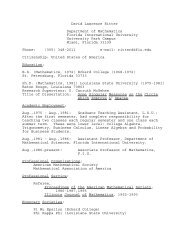You also want an ePaper? Increase the reach of your titles
YUMPU automatically turns print PDFs into web optimized ePapers that Google loves.
judgment call on the part of the hospital administrator. Another<br />
major disaster means a certain shortage, yet any higher level may<br />
be hard to cost justify. Many hospitals do develop joint or regional<br />
groups to share supplies. The basic issue is how to put a price tag<br />
on lifesaving medicines. This is not an easy question to answer,<br />
but it makes for good discussion.<br />
ACTIVE MODEL EXERCISES<br />
ACTIVE MODEL <strong>12</strong>.1: Economic Order Quantity<br />
(EOQ) Model<br />
1. What is the EOQ and what is the lowest total cost?<br />
EOQ 200 units with a cost of $100<br />
2. What is the annual cost of CARRYING inventory at the<br />
EOQ and the annual cost of ORDERING inventory at the EOQ of<br />
200 units.<br />
$50 for carrying and also $50 for ordering<br />
3. From the graph, what can you conclude about the relationship<br />
between the lowest total cost and the costs of ordering and carrying<br />
inventory?<br />
The lowest total cost occurs where the ordering and<br />
inventory costs are the same.<br />
4. How mu<strong>ch</strong> does the total cost increase if the store manager orders<br />
50 MORE hypodermics than the EOQ? 50 LESS hypodermics?<br />
Ordering more increases costs by $2.50 or 2.5%. Ordering<br />
LESS increases costs by $4.17 or 4.17%<br />
5. What happens to the EOQ and total cost when demand is<br />
doubled? When carrying cost is doubled?<br />
The EOQ rises by 82 units (41%) and the total cost rises<br />
by $41 (41%) in EITHER case.<br />
6. Scroll through lower setup cost values and describe the<br />
<strong>ch</strong>anges to the graph. What happens to the EOQ?<br />
The curves seem to drop and move to the left. The EOQ<br />
decreases.<br />
7. Comment on the sensitivity of the EOQ model to errors in<br />
demand or cost estimates.<br />
The total cost is not very sensitive to mistakes in forecasting<br />
demand or placing orders.<br />
ACTIVE MODEL <strong>12</strong>.2: Production Order Quantity<br />
Model<br />
1. What is the optimal production run size for hubcaps?<br />
283<br />
2. How does this compare to the corresponding EOQ model?<br />
The run size is larger than the corresponding EOQ.<br />
3. What is the minimal cost?<br />
$70.71<br />
4. How does this compare to the corresponding EOQ model?<br />
The total cost is less than the cost for the equivalent EOQ<br />
model.<br />
CHAPTER <strong>12</strong> I NVENTORY M ANAGEMENT 185<br />
END-OF-CHAPTER PROBLEMS<br />
<strong>12</strong>.1<br />
Total Cost Unit<br />
Code Cost Demand<br />
XX1 $ 7,008<br />
B66 $ 5,994<br />
3CP0 $ 1,003.52<br />
33CP $ 82,292.16<br />
R2D2 $ 2,220<br />
RMS $ 1,998.88<br />
Total cost $100,516.56<br />
70% of total cost $70,347.92<br />
The item that needs strict control is 33CP so it is an “A” item.<br />
Items that should not be strictly controlled are XX1, B66, 3CP0,<br />
R2D2, and RMS. The “B” items will be XX1 and B66. With so<br />
few items, an exact breakdown into the general A, B, C categories<br />
is flexible.<br />
<strong>12</strong>.2 You decide that the top 20% of the 10 items, based on a<br />
criterion of demand times cost per unit, should be A items. (In this<br />
example, the top 20% constitutes only 58% of the total inventory<br />
value, but in larger samples the value would probably approa<strong>ch</strong><br />
70% to 80%.) You therefore rate items F3 and G2 as A items. The<br />
next 30% of the items are A2, C7, and D1; they represent 23% of<br />
the value and are categorized as B items. The remaining 50% of<br />
the items (items B8, E9, H2, I5, and J8) represent 19% of the<br />
value and become C items.<br />
Annual<br />
Item Demand Cost ($) Demand Cost Classification<br />
A2 3,000 50 150,000 B<br />
B8 4,000 <strong>12</strong> 48,000 C<br />
C7 1,500 45 67,500 B<br />
D1 6,000 10 60,000 B<br />
E9 1,000 20 20,000 C<br />
F3 500 500 250,000 A<br />
G2 300 1,500 450,000 A<br />
H2 600 20 <strong>12</strong>,000 C<br />
I5 1,750 10 17,500 C<br />
J8 2,500 5 <strong>12</strong>,500 C



